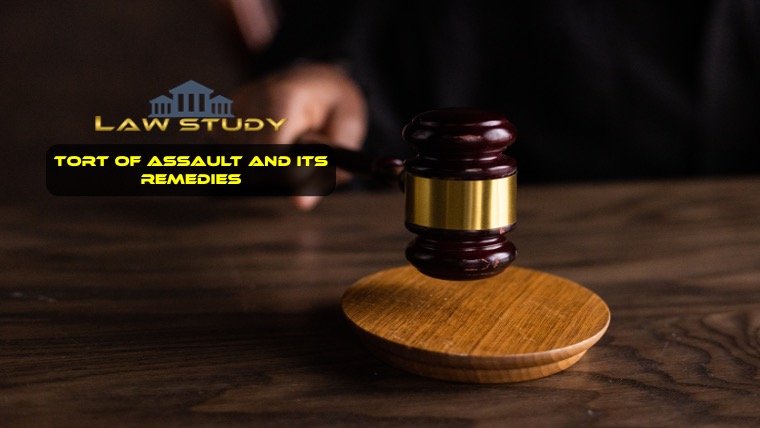Introduction of the Tort of Assault and its Remedies: – Tort law governs the redress for civil wrongful acts. If a person causes unlawful conduct, whether intentionally or accidentally, they might be held accountable. The payment for damages compensates the harmed or aggrieved party.
Definition of a Tort
The term tort comes from the Latin term “Tortum,” which indicates “To Twist.” Tort law refers to unlawful or wrongful acts in which the perpetrator infringes the legal basic rights of another person. The law establishes a duty to respect the rights under the law vested in society’s members, and anyone who fails to do so is considered to have committed wrongful conduct. Intentional conduct, breach of duty, or statutory violations can all result in infringement of law.
Tortfeasor denotes the individual who has committed a tort. When a tortfeasor is found liable for their actions, they must compensate the victim for the injury or harm they have done. In other ways, if a tortfeasor is deemed “responsible” or liable for a person’s harm, he must pay damages.
Tort law provides two fundamental, pervasive specific goals:
- Dissuading the rescuer from committing the same infringement in the future.
- Monetary compensation to the complainant or victim for any damages caused by the breach of defence.
Tort of Assault
Assault is a tort in common law, defined as an act by the defendant that gives the plaintiff a reasonable fear that the defendant may inflict a battery on him. The crime of assault is accomplished when the perpetrator performs his conduct by creating fear in the plaintiff’s mind that he will commit assault against him.
The wrong is defined as an attempt to injure instead of the damage that is caused as a result of that attempt. Charges of assault should contain behaviour that is objectionable or puts another person in danger. This indicates that even if the victim was not physically harmed, one might be charged with assault.
In the particular instance of R. v. S. George, it was determined that pointing a loaded gun at another person was an assault. Even if the gun is not loaded, it could be considered an assault if directed at a distance where it could inflict injury. When someone threatens to use force, this is referred to as assault.
Assault’s basic ingredients
If one or more of the components are not met, it could be used as a defence to an assault charge. The following are aspects of assault crimes:
An act or course of action meant to create:
To establish a Criminal Offensive Attack: The defendants’ behaviour should be motivated by a desire to induce fear or threat in the victim’s mind. Assault allegations are not covered in accident acts.
A reasonable Fear or Apprehension: The victim should also have a reasonable fear that the defendant’s actions will hurt or insult him. The victim should be aware of the defendant’s possible intention of causing the behaviour.
Imminent Damage or Harm: The victim’s fear has to be a direct reaction to an impending threat. Threats like “I’ll beat you tomorrow” would not arise in assault charges in the future. Furthermore, there should be some kind of perception of physical attack or threat to the victim in the damage or loss; as a result, words by themselves would not generally constitute a threat or attack.
It is probably believed that the act of the defendant would endanger or abuse the victim physically. As a result, they try to hit or slap the victim, as well as attempt to spit on the victim, (aggressive behaviour).
If found to be guilty of the threat or attack: All of the above aspects should be present, and the evidence should be supported by the facts & evidence.
It can be challenging to prosecute whether the accused person intended to hurt or attack. Likewise, judges frequently spend a significant amount of time determining whether a defendant’s acts are considered extremely harmful or abusive. In deciding this, they will consider what the average individual might comprehend as harmful and dangerous or aggressive.
Legal defences for assault charges
As with other criminal offences, there may be certain defences to assault charges. This one will be determined by the facts of each specific circumstance, as well as other aspects including such state legislation. Some of the most common assault offences are as follows:
Self-defense: – If the defendant was clearly acting in self-defence, this could be a defence. They must use or exhibit the amount of force which is suitable in the circumstance and proportional to the force to be used against them.
Intoxication: – In certain cases, intoxication can be used as a legal defence, particularly when intoxication impairs a person’s capacity to act willfully.
Coercion: – If the defendant was compelled to intimidate under threat of physical violence, this may be a defence.
Lack of proof: – As aforementioned, this could be used as a legal defence if the aspects of evidence are not revealed or supported by adequate evidence.
Depending on the circumstances, many other different kinds of avoidance may exist.
Important cases
Fagan vs. Metropolitan Police Commissioner
While Fagan was driving his car, a policeman stopped him and ordered him to take the car. Fagan did exactly that, turning his car around and rolling over a policeman’s leg. When the officer ordered him to immediately remove the vehicle from his leg, Fagan swore at him & declined to take the vehicle & stop the car.
Fagan was found guilty of assaulting an officer while he was on duty. Fagan later challenged the ruling, which was reversed. So although assault is a separate crime and should be considered as such, the court determined that, in practice, assault is pretty much similar to battery.
On this grounds, it was determined that Fagan’s offence was not his refusal to move the vehicle, but rather that he had committed a continuous act of battery by driving onto the officer’s foot and refusing to stop. As a result, actus Reus and men’s rea were there, and an assault was committed intentionally. Fagan’s conviction was not overturned.
R. V. Constanza
A man was found guilty of assaulting a female ex-colleague and causing her actual bodily harm. The man followed the woman home from work for about two years, making countless silent calls and messages, writing her over 800 letters, driving past her house, visiting her house without consent, and writing offensive comments on her door 3 times.
She received 2 more texts with offensive language after these actions. She was shortly diagnosed with severe anxiety and depression by a doctor as a result of her perceived terror created by the man’s behaviour and communications.
Remedies
Damages action: – If the plaintiff has been illegally detained, he can always file a lawsuit for damages. monetary compensation may be sought not just for the loss of freedom & liberty, but also for the embarrassment, pain and humiliation that may result. As per McGregor on damages, the specifics of how unlawful imprisonment harms are few: normally, it is neither a monetary loss nor a lack of dignity, and it is left to the jury’s discretion. The harm to liberty, i.e., the loss of time from a non-monetary perspective, and the damage to feelings and emotions, i.e., the integrity, psychological suffering, shame, and any associated absence of social status, appear to be the main types of damage.
Self-help: – This is a recourse or remedy that an individual can use while still in custody, rather than relying on legal action to be taken and so obtaining his release.
Habeas Corpus: – it is a faster way to get a person who has been unfairly detained. A writ may be issued by the S.C. pursuant to Art. 32 or by a High Court pursuant to Art. 226 of the Constitution of India. The person detaining the person is obligated by this writ to present the detained person in front of the court & justify the confinement. If the court determines that the detention is without a just or reasonable and fair reason, the court will order that the person held be freed immediately.
It’s possible that by the time the writ of habeas corpus is decided: – the individual who was illegally detained would have been released. In such instances, the court hearing the petition may give compensation as an ancillary remedy. The Apex Court awarded such remuneration in writs of habeas corpus in the cases of Rudal Shah v. Union of India & Bhim Singh v State of J&K.
Distinction between Assault and Battery
| S.no | Assault | Battery | |
|---|---|---|---|
| 1. | Meaning | Assault is defined as the attempt to commit a battery. | Battery is defined as the intentional use of force against the other person without a justifiable cause. |
| 2. | Crucial Consideration | The threat of violence is sufficient to constitute an assault. Physical contact is not required. | There must be physical contact. |
| 3. | Principle | Construct a reasonable fear in the victim’s mind that instant force & threat will be used. | The same should apply in the absence of any legal justification. |
| 4. | Objective | To make a threat against someone. | To harm someone. |
| 5. | Nature | Not always physically | Physical effort is required. |
Conclusion
Assault is an actually attempted offence; the legislation is meant to prevent battery by penalizing actions that come in a threatening manner to attain battery. As with most initiated crimes, a clear distinction cannot be made between a dangerous criminal threat & conduct that is purely and simply preparation for an attack. There should be a desire to cause injury or harm, but this is grossly inadequate if it inevitably produces the possibility of future harm or damage or battery threat.
Rather, the intent should be removed from immediate danger, such as an unlawful act that endangers the battery. As a result, words thoughts or intentions do not comprise an attack.

























